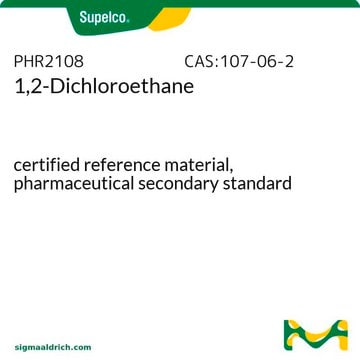319929
1,2-dicloroetano
ACS reagent, ≥99.0%
Sinonimo/i:
Cloruro di etilene, Dicloroetano
About This Item
Prodotti consigliati
Grado
ACS reagent
Livello qualitativo
Densità del vapore
3.4 (20 °C, vs air)
Tensione di vapore
87 mmHg ( 25 °C)
Saggio
≥99.0%
Forma fisica
liquid
Temp. autoaccensione
775 °F
Limite di esplosione
15.6 %
Impurezze
≤0.0003 meq/g Titr. acid
≤0.03% water
Residuo dopo evaporazione
≤0.002%
Colore
APHA: ≤10
clear
Indice di rifrazione
n20/D 1.444 (lit.)
P. eboll.
83 °C (lit.)
Punto di fusione
−35 °C (lit.)
Densità
1.256 g/mL at 25 °C (lit.)
Stringa SMILE
ClCCCl
InChI
1S/C2H4Cl2/c3-1-2-4/h1-2H2
WSLDOOZREJYCGB-UHFFFAOYSA-N
Cerchi prodotti simili? Visita Guida al confronto tra prodotti
Descrizione generale
Applicazioni
- As electron acceptor in the culture medium of Dehalococcoides ethenogenes 195.
- As model compound for chlorinated organics in various studies.
- Chemical doping during the fabrication of Cl-doped few-layer WS2 or MoS2 back gate field-effect transistors (FETs).
Avvertenze
Danger
Indicazioni di pericolo
Classi di pericolo
Acute Tox. 3 Inhalation - Acute Tox. 4 Oral - Asp. Tox. 1 - Carc. 1B - Eye Irrit. 2 - Flam. Liq. 2 - Skin Irrit. 2 - STOT SE 3
Organi bersaglio
Respiratory system
Codice della classe di stoccaggio
3 - Flammable liquids
Classe di pericolosità dell'acqua (WGK)
WGK 3
Punto d’infiammabilità (°F)
55.4 °F - closed cup
Punto d’infiammabilità (°C)
13 °C - closed cup
Certificati d'analisi (COA)
Cerca il Certificati d'analisi (COA) digitando il numero di lotto/batch corrispondente. I numeri di lotto o di batch sono stampati sull'etichetta dei prodotti dopo la parola ‘Lotto’ o ‘Batch’.
Possiedi già questo prodotto?
I documenti relativi ai prodotti acquistati recentemente sono disponibili nell’Archivio dei documenti.
Il team dei nostri ricercatori vanta grande esperienza in tutte le aree della ricerca quali Life Science, scienza dei materiali, sintesi chimica, cromatografia, discipline analitiche, ecc..
Contatta l'Assistenza Tecnica.









